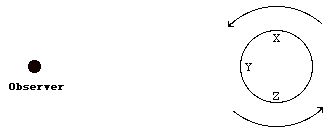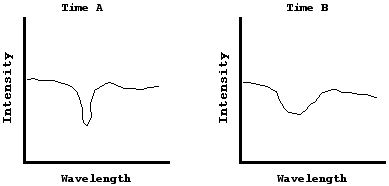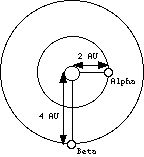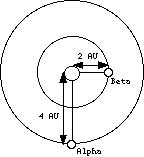
FFFF Light II - Inverse Square Law, Spectral Lines, Doppler Shift
Suppose you’re an observer on a stationary Earth watching the wobble of a distant star as it moves in a tiny circle in response to an unseen orbiting companion planet. As viewed from above, the star seems to move around clockwise in a tiny circle once per year. No explanations are necessary for this problem.

a) (3 pts) At location A, the star’s light appears to be (redshifted, blueshifted, unshifted).
b) (2 pts) At location B, the star’s light appears to be (redshifted, blueshifted, unshifted).
c) (3 pts) The rotation period of the star is increased from one year to two years. State briefly how your answer to (b) changes (for example, if you said “blueshifted”, is it now blueshifted more, less, the same or not at all?).
--
During a total solar eclipse, the Moon completely blocks out the light from the surface of the Sun, enabling us to see the a thin cloud of extremely hot gas that surrounds the Sun on all sides (called the “corona”).
a) When looking at the corona during a solar eclipse, would you expect to see absorption lines or emission lines?
b) Using this information, why could we then determine the composition of the corona?
--
A very bright yellow light bulb is attached to the back of an incredibly fast rocket ship. If the rocket moves away from you quickly, the light becomes very red. Explain what is happening to the wavelength of light and why this appears to us as a change in the color of the light bulb. Use a diagram to help explain your answer (hint: show the light being emitted by a stationary bulb and compare it to the light from the rocket’s bulb).
--
We’ve discussed in class how rotation and wind speed in the atmosphere of a gas giant can result in broadened spectral lines, and we know that the broadening is caused by greater variations in the motions of of the gas (i.e. higher wind speeds result in broader, shallower absorption lines). With this in mind, answer the following:
a) (2 pts) If Saturn were to suddenly heat up to twice its current temperature, would the lines in Saturn’s spectrum get broader or narrower or would there be no change?
b) (4 pts) Explain your answer to part (a).
--
Here is the energy level diagram for a simple atom with one electron. For each of the energies listed below, state (“yes” or “no”) whether or not photons with these energies can be absorbed by a cloud of these atoms in various levels of excitation.

1 eV ________________ 1.5 eV ________________
2 eV ________________ 3 eV __________________
4 eV _________________ 5 eV __________________
--
Of the five major bodies in the inner solar system, only Venus, Earth and Mars have atmospheres. Earth’s Moon and Mercury do not have atmospheres. Suppose we’re looking at two reflection spectra, one from Mars and one from a full Moon. Will the observed absorption line patterns be different? Explain your answer.
--
Explain how the lidar method of detection works to determine a car's speed.
--
No explanations are needed for this question. Simply answer the questions below with a brief sentence. Below is the top view of a person observing a merry-go-round. Children are standing at the locations marked X, Y and Z, and they are all shining flashlights at the observer. Assuming the observer has a very sensitive detection device...
a) (6 pts) How will wavelengths of light from X/Y differ from Y/Z?
b) (6 pts) If the merry-go-round rotates twice as fast, will the wavelengths you observed in part (a) change? If so, how?

--
Since Jupiter/Saturn has an internal heat source, the temperature profile of its atmosphere shows that it is generally cooler the further away one looks from the center of the planet. Bands on Jupiter are regions of high pressure (dark bands, deeper in the atmosphere) and low pressure (light bands, higher up in the atmosphere).
a) (4 pts) Which color bands would you expect to have broader lines? (dark, light, same width, can’t determine)?
b) (8 pts) Explain your answer to part (a).
--
We use our knowledge of spectral lines to determine the composition of distant planetary atmospheres.
a) (8 pts) Explain how and why we can use spectral line analysis to determine the composition of another planet's atmosphere.
b) (6 pts) Some spectral lines are "forbidden" because they are only seen in very low density gases. Explain why they are only seen in very low density gases.
--
Atom X has electron energy levels as shown below: Any electron that has more than 10 energy will escape, leaving the atom ionized.

Which of the following photon energies can be absorbed by an atom in the energy level 3 state? Just write yes/no in each of the four blanks (2 pts each):
1 __________ 3 __________
6 __________ 8 __________
--
Pluto’s moon, Charon, is very massive and orbits around Pluto every 6 days. It is so close to Pluto that it is nearly impossible to resolve these two objects with a telescopic image at such a large distance. Yet years before the first image of Charon was finally obtained, we could have proven the existence of the Moon, Charon, by observing the spectrum of Pluto and its Doppler shift. Explain how.
--
Below is a side-view of the Earth-Moon system. As the Moon orbits the Earth, a laser emits light with a wavelength of 3000 nanometers toward you, the observer (out of the page). No explanations needed for this problem.
a) (2 pts) The light observed from laser A has a wavelength (longer than/shorter than/same as) 3000 nanometers.
b) (2 pts) The light observed from laser B has a wavelength (longer than/shorter than/same as) 3000 nanometers.

c) (4 pts) If the Moon’s average orbital distance from the Earth doubled, would you expect your answers for (a) or (b) to change? If so, how?
--
Suppose we discover a new planet orbiting another star in a highly elliptical orbit. At two different times, a typical absorption line from the planet’s atmosphere looks like this:

We know that the rotation rate of the planet is constant, and we also know from our own experience in the solar system that the closer a planet is to its central star, the warmer it gets.
a) (2 pts) During which of these two times is the orbital velocity of the planet larger?
b) (6 pts) Explain your answer to part (a)
--
Atom X has electron energy levels as shown below: Any electron that has more than 18 energy will escape, leaving the atom ionized.

Which of the following photon energies can be emitted by an atom in the energy level 12 state? Just write yes/no in each of the four blanks (2 pts each):
5 __________ 6 __________
7 __________ 12 __________
--
Below is a top view of the Earth-Moon system. As the Earth rotates, three lasers are pointed at us (at points A, B, C). When at rest, all three emit light with a given wavelength of 5000 nanometers (same for all three lasers). No explanations needed for this problem.
a) (2 pts) The light observed from laser A has a wavelength (longer than/shorter than/same as) 5000 nanometers.
b) (2 pts) The light observed from laser B has a wavelength (longer than/shorter than/same as) 5000 nanometers.

c) (4 pts) If the Moon were twice as far away from the Earth (nothing in the problem changes except the Earth-Moon distance), would your answers to (a) or (b) change? If so, how?
--
Below is a top view of the Earth-Moon system. Astronauts have placed a laser on the surface of the Moon. This laser at all times points in the direction of you, the observer. When at rest relative to you, the laser’s light has a wavelength of 300 nanometers. No explanations are needed for this problem.
a) (2 pts) When the moon is at location A in its orbit, the light observed by you from the laser has a wavelength (longer than/shorter than/same as) 300 nanometers.
b) (2 pts) When the moon is at location B in its orbit, the light observed by you from the laser has a wavelength (longer than/shorter than/same as) 300 nanometers.

c) (4 pts) If the Moon orbited the Earth at twice the current distance, would the wavelengths you observed in parts a and b (not necessarily 300 nanometers in either case) change? If so, how?
--
Suppose we were to detect an asteroid called “Z” in orbit around the Sun at about the same distance from the Sun as the planet Mars (but in a different part of the solar system). “Z” is about 1 km in size and has the same color reflection spectrum (hence, the same geological composition) as the planet Mars. Careful study of the absorption line patterns in these two objects may be helpful, though.
a) (2 pts) Should we expect to see different patterns of spectral lines in these two objects or should they look identical?
b) (6 pts) Explain your answer to part (a).
--
Below is a top view of a newly discovered solar system. This system has a central star exactly the same as our Sun. The two planets in this system are Alpha (2 AU from the star) and Beta (4 AU from the star). We view this system edge-on from Earth, so both Alpha and Beta appear to have Doppler shifts due to their bulk velocity as they orbit the star.
a) (6 pts) When both planets are moving toward/away from us, which one will appear to be blueshifted more (Alpha, Beta, neither one)? If you need to refer to the equation of orbital velocity, it is given elsewhere in the exam. Explain.
 /
/ 
b) (6 pts) The inverse square law tells us that that the intensity of light received by a planet is proportional to 1/r2, where r is the distance from the planet to the star it orbits around. State how much light planet Alpha receives compared to planet Beta (e.g. “Alpha receives 15 times more light than Beta”). No explanation necessary here, but show work for possible partial credit if wrong.
--
In the element Froggium, electrons are only allowed to exist at energy levels corresponding to energies of E=0 and E=17/15/12. In the element Ponium, electrons are only allowed to exist at energy levels corresponding to energies of E=0 and E=19/12/15. Each of these two atoms has an electron in the higher energy level, and both atoms’ electrons jump down to the lower level, emitting a photon in the process. Which atom will emit a photon with a longer/longer/shorter wavelength? Explain in words or with some simple mathematics.
--
Below is a top view of a newly discovered solar system. This system has a central star exactly the same as our Sun. The two planets in this system are Alpha (2 AU from the star) and Beta (4 AU from the star). We view this system face-on (as opposed to edge-on) as seen from Earth, so both Alpha and Beta appear to move transversely as they orbit their star.
a) (6 pts) When both planets are observed over time, which one will appear to show larger Doppler shifts (Alpha, Beta, neither one)? If you need to refer to the equation of orbital velocity, it is given elsewhere in the exam. Explain.

b) (6 pts) The inverse square law tells us that that the intensity of light received by a planet is proportional to 1/r2, where r is the distance from the planet to the star it orbits around. State how much light planet Beta receives compared to planet Alpha (e.g. “Beta receives 15 times more light than Alpha”). No explanation necessary here, but show work for possible partial credit if wrong.
--
We know that Jupiter has an internal heat source because when we look at the planet with longer and longer wavelengths, the width of the spectral lines in Jupiter’s spectrum get broader and broader.
a) (4 pts) Explain why temperature and spectral line width are related in this way.
b) (4 pts) Explain why longer wavelengths probe deeper into Jupiter’s atmosphere.
--
Suppose an observer at a stationary location on Earth is viewing the distant planet X and measuring the Doppler shift of spectral lines from different locations on X. As viewed from above, the planet rotates counterclockwise, as shown below

/

a) (2 pts) Light from A will appear (redshifted, blueshifted, unshifted).
b) (2 pts) Briefly state how your answer to (a) would change if the rotation velocity of the planet were doubled.
c) (2 pts) Light from B will appear (redshifted, blueshifted, unshifted).
d) (2 pts) Briefly state how your answer to (c) would change if the rotation velocity of the planet were doubled.
--
Suppose you’re an observer on a stationary Earth watching the wobble of a distant star as it moves in a tiny circle in response to an unseen orbiting companion planet. As viewed from above, the star seems to move around clockwise in a tiny circle once per year. No explanations are necessary for this problem.

/

a) (3 pts) At location A, the star’s light appears to be (redshifted, blueshifted, unshifted).
b) (2 pts) At location B, the star’s light appears to be (redshifted, blueshifted, unshifted).
c) (3 pts) The rotation period of the star is increased from one year to two years. State briefly how your answer to (b) changes (for example, if you said “blueshifted”, is it now blueshifted more, less, the same or not at all?).
--
Below is an emission line spectrum from a lamp located here on Earth, at rest relative to the telescope you're using for your observations.
a) (7 pts) On the blank spectrum below, sketch the spectrum of an emission line from a planetary atmosphere that is moving away from the Earth. Also assume that the planet is rotating quickly, and that we are seeing the planet edge-on (we are in that planet's equatorial plane). No explanation needed.

b) (7 pts) Is there a difference in emission line width when you compare the lamp spectrum to the planetary atmosphere spectrum? If so, explain why. If not, explain why not.
--
Suppose two planets, X and Y, have the same absorption line patterns in their atmospheres. Planet X is closer to the Sun and therefore hotter than planet Y.
a) (2 pts) Will the absorption lines from planet X tend to be broader, narrower or the same size compared to the absorption lines from planet Y?
b) (12 pts) Explain in detail why the absorption lines from X will or won't be any different from planet Y (just saying something like "X is hotter than Y, so the absorption lines are therefore _______" is just repeating the information given and will result in no credit).
--
Explain how and why we can determine the temperature (using continuous radiation) and composition (using absorption/emission line radiation) of a planetary atmosphere from a distance.
--
Explain how and why we can use information about spectral line widths in the atmosphere of a planet to estimate its temperature.
--
Explain briefly why we can use spectra to deduce the composition of a distant gas, then explain how astronomers use this principle to determine the atmospheric composition of a planet like Mars.